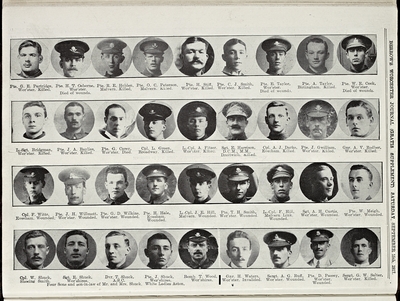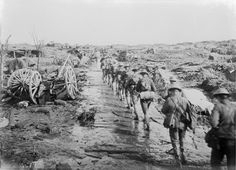The Third Battle of Ypres commences - 31 July 1917
31st July 2017
On July 31, 1917, the Allies launch a renewed assault on German lines in the Flanders region of Belgium, in the much-contested region near Ypres, during World War I. The attack begins more than three months of brutal fighting, known as the Third Battle of Ypres. On 31 July alone 72 Worcestershire men lost their lives.

The Third Battle of Ypres was spearheaded by the British commander in chief, Sir Douglas Haig. The aggressive and meticulously planned offensive, ostensibly aimed at destroying German submarine bases located on the north coast of Belgium, was in fact driven by Haig’s (mistaken) belief that the German army was on the verge of collapse, and would be broken completely by a major Allied victory.
After an opening barrage of some 3,000 guns, Haig ordered nine British divisions, led by Sir Hubert Gough’s 5th Army, to advance on the German lines near the Belgian village of Passchendaele on July 31; they were joined by six French divisions. In the first two days of the attacks, while suffering heavy casualties, the Allies made significant advances–in some sectors pushing the Germans back more than a mile and taking more than 5,000 German prisoners–if not as significant as Haig had envisioned. The offensive was renewed in mid-August, though heavy rains and thickening mud severely hampered the effectiveness of Allied infantry and artillery and prevented substantial gains over the majority of the summer and early fall.

Dissatisfied with his army’s gains by the end of August, Haig had replaced Gough with Herbert Plumer at the head of the attack; after several small gains in September, the British were able to establish control over the ridge of land east of Ypres. Encouraged, Haig pushed Plumer to continue the attacks towards the Passchendaele ridge, some 10 kilometers from Ypres.
Thus the Third Battle of Ypres–also known as Passchendaele, for the village, and the ridge surrounding it, that saw the heaviest fighting–continued into its third month, as the Allied attackers reached near-exhaustion, with few notable gains, and the Germans reinforced their positions in the region with reserve troops released from the Eastern Front, where Russia’s army was foundering amid internal turmoil.
Unwilling to give up, Haig ordered a final three attacks on Passchendaele in late October. The eventual capture of the village, by Canadian and British troops, on November 6, 1917, allowed Haig to finally call off the offensive, claiming victory, despite some 310,000 British casualties, as opposed to 260,000 on the German side, and a failure to create any substantial breakthrough, or change of momentum, on the Western Front.
By the end of the Third Ypres, nine Battalions of the Worcestershire regiment had been involved in the fighting. 1st Battalion of Worcestershire Regiment were in first wave of attacks on the night of 30/31st July, known as the Battle of Pilckem Ridge, and were successful in reaching the Westhoek Ridge. However, cloud soon turned to heavy rain, tanks were bogged down and ditched and casualties rose.
You can read the full list of men who lost their lives on 31 July here.
10th Battalion moved into attack on 2/3 August on the Menin Road. Rain, heavy shelling and water-logged ground held them up. Both the Medical Officer and the Chaplain were killed during this attack.
The 4th Battalion entered the fighting for Langemarck on 16th August where 19 year old Captain Paddison was killed. Around the Steenbeek at St. Julien the Territorials 1/7th Worcestershire barely made any ground at all. The second line Territorials in 2/7th and 2/8th came up to support.
August became September and the 2nd Worcestershire's joined the fray on 24th in the Battle of the Menin Road, holding out against a German counter-attack. September also saw the first action for 14th Battalion of Pioneers, attached to the (63rd) Royal Naval Division.
Given its outcome, the Third Battle of Ypres remains one of the most costly and controversial offensives of World War I, representing–at least for the British–the epitome of the wasteful and futile nature of trench warfare.
The source of information for the above is history.com
You can read more about the Worcestershire Regiment’s role in the Battle of Ypres here and here.